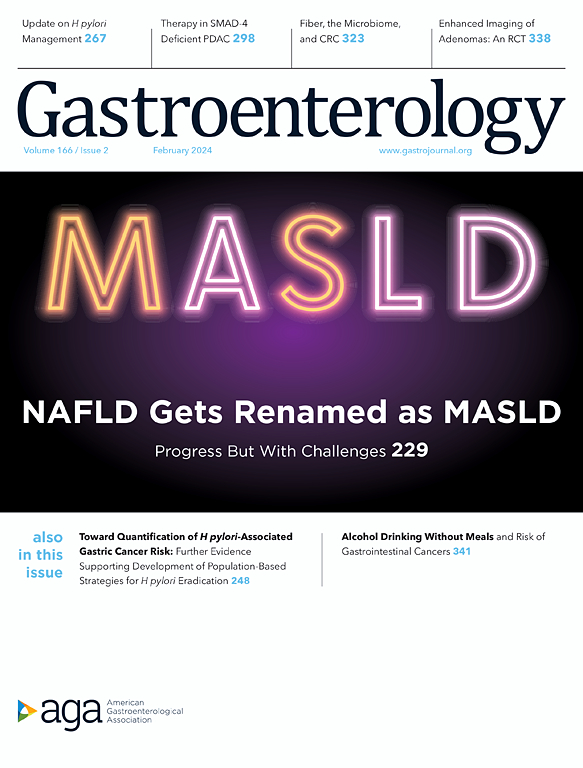用于息肉切除术后结直肠癌监测的粪便检测可安全减少结肠镜检查次数:MOCCAS 研究。
IF 25.7
1区 医学
Q1 GASTROENTEROLOGY & HEPATOLOGY
引用次数: 0
摘要
背景和目的:为预防结肠直肠癌(CRC)而进行的结肠镜检查给患者和医疗保健带来了巨大负担。粪便检测可将结肠镜检查限制在大肠癌风险较高的人群中,从而有助于减少结肠镜检查次数:这项横断面观察性研究包括年龄在 50-75 岁之间、有监测指征的人。在准备排便前,参与者采集样本进行多靶点粪便 DNA(mt-sDNA)检测和两种粪便免疫化学检测(FIT)。我们计算了所有监测适应症的检测准确率。ASCCA模型仅评估了最常见且与相对较低的 CRC 风险相关的息肉切除术后适应症对粪便监测的长期影响。对粪便监测策略进行了模拟,以调整每项检测的阳性阈值,从而获得至少与结肠镜监测同样有效的策略:结果:3453 人获得了所有粪便检测和结肠镜检查的结果。其中 2226 人曾做过息肉切除术,1003 人曾患过 CRC,224 人有家族遗传风险。mt-sDNA检测的AN接收器操作特征曲线下面积为0.72(95% CI;0.69-0.75),FIT OC-Sensor的AN接收器操作特征曲线下面积为0.61(95% CI;0.58-0.64),FIT FOB-Gold的AN接收器操作特征曲线下面积为0.59(95% CI;0.56-0.61)。基于粪便的息肉切除术后监测策略至少与结肠镜监测同样有效,可将结肠镜检查次数减少 15-41%,在人的一生中需要进行 5.6-9.5 次粪便检测。基于 Mt-sDNA 的监测比结肠镜监测成本更高,而基于 FIT 的监测则节省了成本:这项研究表明,基于粪便的息肉切除术后监测策略既安全又经济,有可能将结肠镜检查次数最多减少 41%。本文章由计算机程序翻译,如有差异,请以英文原文为准。

Stool-Based Testing for Post-Polypectomy Colorectal Cancer Surveillance Safely Reduces Colonoscopies: The MOCCAS Study
Background & Aims
Colonoscopy-based surveillance to prevent colorectal cancer (CRC) causes substantial burden for patients and health care. Stool tests may help to reduce surveillance colonoscopies by limiting colonoscopies to individuals at increased risk of advanced neoplasia.
Methods
This cross-sectional observational study included individuals aged 50–75 years with surveillance indication. Before bowel preparation, participants collected samples for a multitarget stool DNA test and 2 fecal immunochemical tests (FITs). Test accuracy was calculated for all surveillance indications. For the post-polypectomy indication only, which is the most common and is associated with a relatively low CRC risk, long-term impact of stool-based surveillance was evaluated with the Adenoma and Serrated Pathway to Colorectal Cancer (ASCCA) model. Stool-based strategies were simulated to tune each test’s positivity threshold to obtain strategies at least as effective as colonoscopy surveillance.
Results
There were 3453 individuals with results for all stool tests and colonoscopy; 2226 had previous polypectomy, 1003 had previous CRC, and 224 had a familial risk. Areas under the receiver operating characteristic curve for advanced neoplasia were 0.72 (95% CI, 0.69–0.75) for the multitarget stool DNA test, 0.61 (95% CI, 0.58–0.64) for the FIT OC-SENSOR (Eiken Chemical Co, Tokyo, Japan) and 0.59 (95% CI, 0.56–0.61) for the FIT FOB-Gold (Sentinel, Milan, Italy). Stool-based post-polypectomy surveillance strategies at least as effective as colonoscopy surveillance reduced the number of colonoscopies by 15%–41% and required 5.6–9.5 stool tests over a person’s lifetime. Multitarget stool DNA–based surveillance was more costly than colonoscopy surveillance, whereas FIT-based surveillance saved costs.
Conclusions
This study found that stool-based post-polypectomy surveillance strategies can be safe and cost-effective, with potential to reduce the number of colonoscopies by up to 41%. ClinicalTrials.gov, Number: NCT02715141.
求助全文
通过发布文献求助,成功后即可免费获取论文全文。
去求助
来源期刊

Gastroenterology
医学-胃肠肝病学
CiteScore
45.60
自引率
2.40%
发文量
4366
审稿时长
26 days
期刊介绍:
Gastroenterology is the most prominent journal in the field of gastrointestinal disease. It is the flagship journal of the American Gastroenterological Association and delivers authoritative coverage of clinical, translational, and basic studies of all aspects of the digestive system, including the liver and pancreas, as well as nutrition.
Some regular features of Gastroenterology include original research studies by leading authorities, comprehensive reviews and perspectives on important topics in adult and pediatric gastroenterology and hepatology. The journal also includes features such as editorials, correspondence, and commentaries, as well as special sections like "Mentoring, Education and Training Corner," "Diversity, Equity and Inclusion in GI," "Gastro Digest," "Gastro Curbside Consult," and "Gastro Grand Rounds."
Gastroenterology also provides digital media materials such as videos and "GI Rapid Reel" animations. It is abstracted and indexed in various databases including Scopus, Biological Abstracts, Current Contents, Embase, Nutrition Abstracts, Chemical Abstracts, Current Awareness in Biological Sciences, PubMed/Medline, and the Science Citation Index.
 求助内容:
求助内容: 应助结果提醒方式:
应助结果提醒方式:


